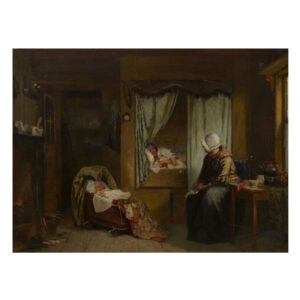Americanism Redux
September 28, 250 years ago today
The parents looked down at the crib. Their baby, their first, is two days old. A beautiful daughter. Maybe something is not quite right, a little too pale and a little too fussy and a little too congested. Well, who knows. Maybe everything will be fine.
Mom is Martha, nicknamed Patty by her husband, who is Tom. Patty and Tom were married almost exactly nine months ago today, suggesting that they hurdled chairs, sprinted through rooms, and leaped two steps at a time up the staircase to get to their wedding bed after saying their vows on New Year’s Day. Patty and Tom are in love, and daughter Patsy will be the better for it today, 250 years ago.
She’ll have only one grandfather to grow up with. It’s Patty’s father, and Tom’s father-in-law. He’s John, grandfather John. Grandpa has a bit of a problem in that he has a second, semi-secret family with his mistress, a woman named Hemings of mixed race, half-white and half-black. It’s the black heritage of Hemings that makes her legally enslaved to Grandpa John in the British colony of Virginia. Grandpa John and Hemings have five children in the semi-secret family as of now, and each is a half-sibling to Patty, Tom’s wife. Patty and Tom’s two-day old baby girl will grow up in a family web.
Tom is obsessed with building a new house for his new family. But not just any house. The vision in the mind of Tom Jefferson is of a magnificent work of art taking the form of a structure where his family will live. The walls and floors will be the canvas and Tom will be the master artist who brings it all to life on top of the mountain where Monticello will stand—preside—as a showcase in southern Virginia. The first dirt of the foundation is turned, and the first timbers and stone are being laid, all by enslaved workers, of course.
A very tall man rides his horse to a newly built church across the southern border of Virginia. The clapboard building stands in Currituck County, North Carolina, part of the colony’s outer banks. He is Reverend Joseph Pilmore and today he delivers the first Methodist sermon ever given in the colony of North Carolina. Born to parents not married, Pilmore is one of two Methodist preachers sent by Methodism’s founder John Wesley to North America. The congregation stares at Pilmore, his long hair laying over his collar. He announces the text for his sermon: “He shall baptize you with the Holy Ghost and with fire (Matthew 3:11).” His booming voice seems to shake the rafters and rattle the windows. The people listen eagerly to him. They rush the pulpit after the sermon, welcoming Pilmore to their community. The people in this church will one day soon see a specter if not a ghost and a burning if not a fire.
A boundary line. First Methodist preacher, Pilmore on the southern side. First Monticello baby, Patsy on the northern side. Today, 250 years ago, a church family welcomes one and a Jefferson family welcomes the other.
Also
Today, 250 years ago, members of the national political class in England grapple with what to do about the East India Company. Given authority years ago to extend British rule and British economy into India, the EIC is nearly bankrupt. But it’s too big to fail, as they might say one day in the future. Too many ties bind Parliament and the political class to the EIC, and the EIC is dependent on those ties for survival. Members of Parliament, advisors to George III, and various officials have negotiated for weeks behind closed doors. Special pricing, buy-backs, stock options, monopolized markets, appointed jobs with salaries, side-deals on items other than tea (EIC’s core product), and countless other bargaining chips are moving off and on tables.
The only thing worth predicting is that the result will be a smelly heap of mutual interest. Real solutions and positive change will be flecks in the steaming pile. The clearest thing will be the stink. Enjoy.
A group of frustrated men and women grumble in various towns and villages of every British colony along the North American Atlantic Coast. A few are louder than the others, more resentful and fearful. Among that smaller crowd are a handful of people scratching their ideas across loose sheets of parchment paper. One, Samuel Adams, writes long into the nights, building his argument much like the mountain-top house in southern Virginia, which still mostly exists in the mind of Thomas Jefferson. Adams and Jefferson are alike in that they draw images from a classical and ancient world to transplant to their New World. But one looks out his window and sees steeples and ship masts, while the other looks out his window and sees forests, gardens, and hills. Can such a sight intersect?
For You Now
The world as it is and the time when something or someone new and first arrives.
That’s exactly Patty Jefferson and Joseph Pilmore today 250 years ago.
JP starts on a mission created by a founder. PJ begins a life with things rooted all around her.
New and first or first and new, the order matters so.
Suggestion
Rhyme over repeat and poem over mirror. Is a manner of the former clearer now in your American autumn?











